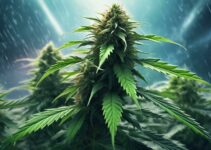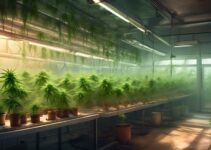Imagine your cannabis seedlings reaching up towards the sunlight, their leaves unfurling and soaking in every ray. Maximizing light cycles for robust cannabis seedlings is essential for ensuring healthy and vigorous growth. But how do you ensure that your seedlings are getting the right amount and quality of light to thrive? Understanding the intricacies of light cycles, proper spectrum, duration, and timing of light exposure is crucial. Join us as we explore the best practices for maximizing light cycles to cultivate robust cannabis seedlings, and learn how to troubleshoot any issues that may arise along the way.
Key Takeaways
- Light cycles are crucial for the transition from vegetative growth to flowering in cannabis seedlings.
- Different stages of growth require specific light spectrums, with blue light being important for vegetative growth and red light for flowering.
- Consistency in the duration and timing of light exposure, such as transitioning to a 12-hour light and 12-hour dark cycle for flowering, maximizes growth and yield.
- Proper management of light intensity is essential for optimal growth, as inadequate or excessive light can harm seedlings' progress and development.
Understanding Light Cycles for Seedlings
Understanding the light cycles for cannabis seedlings is crucial for optimizing growth and ensuring healthy development. Light cycles play a pivotal role in the transition from vegetative growth to flowering in the plant's life cycle. During the vegetative stage, your indoor cannabis seedlings require specific light exposure to thrive. It's essential to consider both the duration and intensity of light for your seedlings.
When seed germination occurs, the initial light cycle should consist of 18 hours of light exposure followed by 6 hours of darkness. This prolonged light exposure encourages the seedlings to convert light energy into chemical energy, promoting robust growth. As the seedlings progress through the vegetative stage, gradually transitioning to a 12-hour light cycle and 12-hour dark cycle is crucial to stimulate the transition to flowering.
Optimal light intensity is also key during the vegetative stage. Providing 600 to 1000 µmol/m²/s of light intensity ensures that the seedlings receive adequate light for photosynthesis without causing light stress.
Understanding and meticulously controlling light cycles for your cannabis seedlings will significantly impact their growth and overall yield.
Importance of Proper Light Spectrum
Proper light spectrum is a critical factor in maximizing the growth and flowering of cannabis seedlings, directly impacting their developmental processes and overall quality. When considering the light spectrum for your indoor cannabis plants, it's essential to understand that different stages of the plants' growth cycle require specific light spectrums. During the vegetative stage, blue light is crucial for promoting strong, healthy stem and leaf growth. As your cannabis plants transition into the flowering stage, red light becomes vital for stimulating the production of flowers and fruits. Utilizing LED grow lights with adjustable spectrums allows you to provide the precise light spectrum needed at each stage of growth. Understanding and implementing the proper light spectrum not only optimizes plant growth but also influences the production of essential compounds, ultimately impacting the potency and quality of your cannabis. Adjusting your lighting schedule and using the right light sources based on the specific light spectrum needs of cannabis seedlings can create an ideal environment for robust and healthy plant development.
Duration and Timing of Light Exposure
To maximize the growth potential of your cannabis seedlings, understanding the optimal light duration, peak timing for growth, and light exposure intervals is crucial. By strategically manipulating the duration and timing of light exposure, you can effectively influence the vegetative and flowering stages of your plants. This level of control over light cycles is essential for achieving rapid growth and maximizing flower production.
Optimal Light Duration
Optimizing cannabis seedling growth requires determining the appropriate duration and timing of light exposure, crucial for promoting rapid development. When it comes to light duration, seedlings typically require 18 to 24 hours of specific light per day to meet their light requirements. Ensuring the transition from the vegetative stage to the flowering stage involves manipulating the light cycle, transitioning from 18-24 hours of light to 12 hours of light and 12 hours of darkness. This manipulation is essential for overall yield and growth, especially for indoor growers. Consistency in the light schedule is essential for maximizing growth and yield, and utilizing a timer can help automate the light cycle, ensuring that the plants receive the necessary light and darkness at the right times.
Peak Timing for Growth
Moving from the discussion of optimal light duration for cannabis seedlings, the crucial focus now shifts to determining the peak timing for growth through the duration and timing of light exposure. Achieving robust cannabis seedlings is contingent upon understanding the ideal light cycles during the vegetative and flowering stages. Consistent light schedules are crucial for achieving optimal and consistent growth, ultimately leading to higher yields. The table below summarizes the recommended light cycles for each growth stage in cannabis cultivation.
| Growth Stage | Light Duration |
|---|---|
| Vegetative | 18-24 hours |
| Flowering | 12 hours light, 12 hours uninterrupted darkness |
Light Exposure Intervals
Light exposure intervals play a critical role in determining the duration and timing of light exposure for optimal growth and development of cannabis seedlings. To achieve maximum growth and robust seedlings, it is essential to carefully manage the hours of light and light conditions. When adjusting light exposure intervals, consider the specific needs of different cannabis strains at each stage of growth. Properly timed light exposure intervals can significantly impact the flowering process, leading to healthier and more vigorous seedlings. By understanding and adjusting light exposure intervals to suit the growth and development of cannabis seedlings, you can promote robust and healthy plants. Efficient management of light exposure intervals is crucial for ensuring the successful cultivation of cannabis seedlings.
Common Mistakes in Regulating Light Cycles
When regulating light cycles for cannabis seedlings, it's crucial to carefully time light exposure to meet the specific needs of the plants. Understanding the optimal light intensity for each growth phase and consistently managing it is essential for healthy plant development. Common mistakes in regulating light cycles can lead to stress and reduced productivity in cannabis seedlings.
Timing Light Exposure
To optimize cannabis seedling growth, it is imperative to meticulously regulate the timing of light exposure, avoiding any deviations that could adversely impact the plant's development and productivity. When considering the timing of light exposure, there are crucial factors to consider:
- Duration of Light: Providing light for 12 hours per day during the vegetative stage is essential for healthy growth.
- Transition Period: As plants transition to the flowering stage, they need extended light exposure to prevent premature flowering.
- Avoiding Excessive Light: Overexposing plants to light can disrupt their natural cycle and impede growth.
Understanding these factors is critical as growers can manipulate light schedules to maximize plant potential. By avoiding the pitfall of exposing the plants to light too much, you can ensure the robust development of your cannabis seedlings.
Understanding Plant Needs
Understanding the specific light requirements of cannabis seedlings is essential for avoiding common mistakes in regulating light cycles and ensuring optimal growth and flowering. The amount of light needed varies at different stages of growth and development. In the vegetative stage, cannabis seedlings typically require 18-24 hours of light to promote robust growth. However, during the flowering stage, a 12-hour light cycle is necessary to stimulate the production of flowers. This understanding is crucial for maximizing light cycles and overall quality. Inadequate light can lead to stunted growth and reduced nutrient uptake, impacting the plant's health. Additionally, providing the appropriate hours of darkness is equally important in supporting healthy development. By comprehending the plant's light requirements at different stages, you can avoid common mistakes and foster the robust growth of cannabis seedlings.
Managing Light Intensity
Ensuring consistent light intensity throughout various growth stages is essential for promoting healthy development in cannabis seedlings. As a cannabis grower, you need to understand the critical role that light intensity plays in maximizing your plants' potential. Here are common mistakes to avoid when managing light intensity:
- Underestimating the impact of light intensity: Inadequate light can stunt growth and reduce yield potential.
- Overexposure to high light intensity: Excessive light can harm seedlings, affecting their ability to progress from the vegetative stage to the flowering stage.
- Failing to adjust light intensity based on growth stage: Proper management of light intensity is crucial for ensuring optimal growth and creating the right growing conditions for robust cannabis seedlings. Remember, slight variations in light intensity can significantly impact your plants' development and productivity.
Best Lighting Considerations for Vegetative Growth
During the vegetative growth stage, it is crucial to provide cannabis seedlings with the appropriate light spectrum and intensity to support healthy and robust development. Choosing the right type of light is essential for promoting strong stems and overall vigorous growth. LED grow lights are highly recommended as they offer a full spectrum suitable for all stages of the plants' development. These lights provide the necessary blue light for strong root and stem growth, as well as red light to support overall vegetative development. Fluorescent lights can also be used effectively during this stage, especially for small-scale operations.
To further understand the importance of light spectrum and intensity during the vegetative growth stage, consider the following table:
| Light Type | Spectrum Provided | Suitability |
|---|---|---|
| LED Grow Lights | Full spectrum (blue, red) | Highly suitable |
| Fluorescent Lights | Limited spectrum | Suitable for small-scale operations |
| High-Intensity Discharge (HID) Lights | Full spectrum | Suitable for larger operations |
Optimal Lighting Considerations for Flowering
As you optimize the lighting for the flowering stage of cannabis seedlings, it's crucial to maintain the momentum from the vegetative growth stage by ensuring a seamless transition of the light spectrum and intensity for continued healthy and robust development. The flowering stage is a critical period for the production of cannabinoids, especially THC. To ensure optimal lighting considerations for flowering, pay close attention to the following:
- Light Cycles: Adjust the light cycle to 12 hours of light and 12 hours of uninterrupted darkness to mimic the late summer conditions that trigger flowering in outdoor cannabis plants. This will promote robust flowering and maximize THC content.
- Humidity Levels: Control humidity levels to prevent mold and mildew, especially during the flowering stage when the plants are more susceptible. Maintain humidity levels between 40-50% to ensure healthy growth patterns and prevent any adverse effects on cannabinoid profiles.
- Optimal Lighting: During flowering, focus on providing the right light spectrum, including red and far-red light, to stimulate bud development and maximize resin production. Ensure the light intensity is appropriate to support robust seedlings and encourage the development of high-quality flowers with the desired cannabinoid profiles.
Troubleshooting Light Schedule Issues
To troubleshoot light schedule issues, carefully assess the consistency and adequacy of the lighting regimen throughout the cannabis seedlings' growth cycle. Consistency in the light schedule is critical for maximizing light cycles and ensuring robust cannabis seedlings. Cannabis cultivators must pay close attention to the duration and intensity of light exposure at each growth stage to achieve desired results. Inadequate or inconsistent lighting can have a significant impact on the plants, leading to issues such as stunted growth, light stress, or improper development. When troubleshooting light schedule issues, it's essential to monitor and maintain optimal light intensity to prevent any adverse effects on the young plants. Additionally, disruptions in the light schedule can disrupt the plants' natural processes and lead to undesirable outcomes. Careful observation and adjustment of the light schedule are necessary to address any issues that may arise and ensure that the cannabis seedlings receive the appropriate light spectrum and duration for their specific growth stage.
Frequently Asked Questions
How Long Should Light Be on for Cannabis Seedlings?
For cannabis seedlings, light duration directly impacts growth rates, leaf development, and nutrient absorption. To maximize energy consumption and root growth, ensure a consistent light schedule of 18-24 hours per day, at a suitable light distance and with an optimal light spectrum.
What Is the Best Light Intensity for Cannabis Seedlings?
For robust cannabis seedlings, the best light intensity is 100-180 µmol/m2/s. Ensure proper light spectrum, distance, and duration for optimal growth. Adjust light fixtures, schedule, and acclimation to avoid light stress and maximize penetration.
Is Sunlight Too Strong for Cannabis Seedlings?
Direct sunlight can be too strong for cannabis seedlings, potentially causing light stress and affecting seedling growth. Managing light exposure, spectrum, distance, and duration is crucial for seedling development and health. Gradual light acclimation can help mitigate these issues.
How High Should LED Grow Lights Be Above Seedlings?
Keep LED grow lights 24-36 inches above seedlings to prevent light burn. Adjust height as seedlings grow to maintain light intensity. Use blue light spectrum for healthy growth. Keep lights on for 18-24 hours/day to support seedling development. Regularly monitor for stretching or light stress and adjust light height accordingly.





